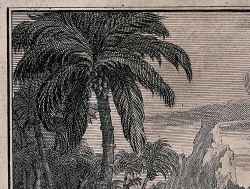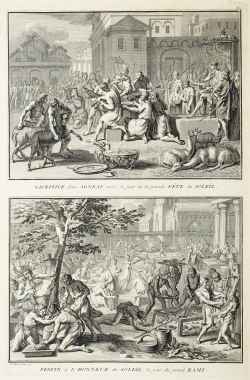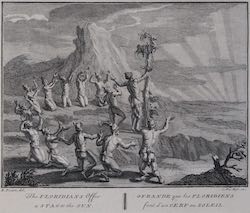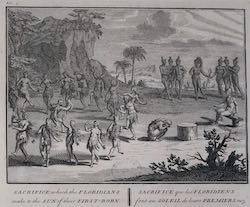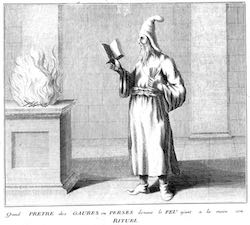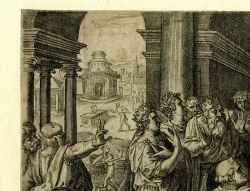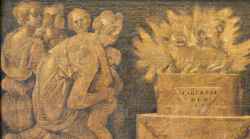Topic: 2. Sacrifice and religion: Comparisons, Antiquarians, Anthropology (16th-18th Century)
Religious sacrifices across various cultures and contexts sparked widespread interest in Early Modern Europe. As Christianity expanded into regions inhabited by "infidels" and "pagans", Europeans encountered a diverse array of sacrificial customs, ranging from the Sati rituals in India to the Aztec sacrifices in the Americas. This cross-cultural exposure captivated a wide audience, including theologians, philosophers, political thinkers, antiquarians, orientalists, missionaries, poets, artists, and even the general public. These encounters broadened the European understanding of sacrifice and led to a critical reassessment of classical and biblical sacrificial rites. This section includes:
- Sources: A selection of early modern printed materials, which include descriptions of the Americas, Asia, and Africa, alongside antiquarian and philological studies on religious sacrifice in classical antiquity and beyond. It also presents early modern works of ethnological observations and the first attempts to compare different sacrificial practices in various traditions and contexts, laying the groundwork for disciplines like the history of religions and anthropology.
- Iconographic Representations: A rich collection of images from the 16th to 18th centuries, illustrating a range of sacrificial rituals and practices as seen in different cultural and geographical contexts.
- Related Bibliography: An extensive bibliography spanning scholarly works from the 19th to 21st centuries, providing contemporary analyses and interpretations of these early studies and observations.
Manner in which the Women in India Burn (1728)
from: Picart, B. Ceremonies et Coutumes Religieuses des Peuples Idolatres, tome II, Amsterdam, 1728
London, Wellcome Collection
Manner in which they Bury Themselves (1728)
from: Picart, B. Ceremonies et Coutumes Religieuses des Peuples Idolatres, tome II, Amsterdam, 1728
London, Wellcome Collection
Mexican Sacrifice to the God of Hunting (1723 - 1743)
from: Picart, Bernard; Bernard, Jean Frederic. Religious Ceremonies and Customs of All the Peoples of the World, 1723-1743
Sacrifice d'un Agneau Noir, le jour de la grande fête du Soleil (1723)
Smithsonian American Art Museum
Sacrifice of Iphigenia (1723 - 1743)
from: Picart, Bernard; Bernard, Jean Frederic. Religious Ceremonies and Customs of All the Peoples of the World, 1723-1743
Sacrifice which the Floridians Make to the Sun (lower) (1723 - 1743)
from: Picart, Bernrd; Bernard, Jean Frederic. Religious Ceremonies and Customs of All the Peoples of the World, 1723-1743
Sacrifice which the Floridians make to the Sun (upper) (1723 - 1743)
from: Picart, Bernard; Bernard, Jean Frederic. Religious Ceremonies and Customs of All the Peoples of the World, 1723-1743
The Great Sacrifice of the Canadians Indians (1723 - 1743)
from: Picart, Bernard; Bernard, Jean Frederic. Religious Ceremonies and Customs of All the Peoples of the World, 1723-1743
Zoroastrian Priest Makes a Sacrifice (1723 - 1743)
from: Picart, Bernard; Bernard, Jean Frederic. Religious Ceremonies and Customs of All the Peoples of the World, 1723-1743
The sacrifice at the altar of Apollo (1571)
Rijksmuseum, Amsterdam
De orbe nouo Petri Martyris ab Angleria Mediolanensis Protonotarij Cesaris senatoris decade
Compluti · Alcala de Henares: Egino, 1530.
The Sacrifice of Polixena at the Tomb of Achilles [1735]
The Walter Art Museum, Baltimore
The sacrifice of Polyxena [1732 - 1733]
Getty Museum, Getty Villa, Malibù
The sacrifice of Polyxena [1737]
Staatsgalerie, Würzburg
Etnografia umanistica ne L'epistola sulla religione ed i sacrifici degli antichi prussiani di Jan Sandecki Malecki (Meletius)
in: Studia mythologica Slavica, v. 3 (2000), issue : pp.63-74.
Scene of a sacrifice [1545]
Museo Capodimonte, Napoli
Ghosts and Religious Life in Early China
Cambridge: Cambridge University Press, 2022.


